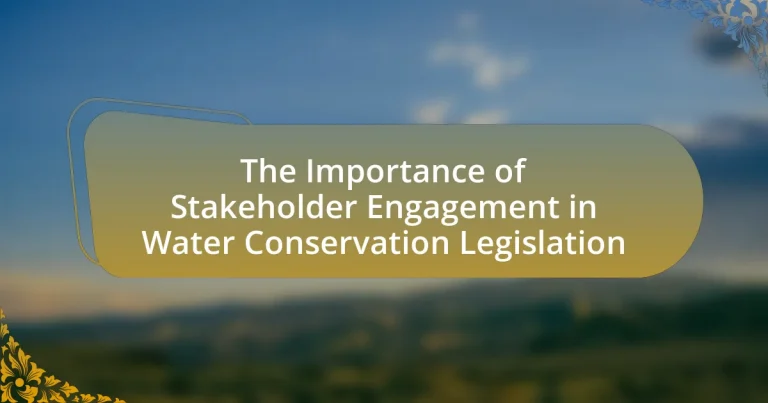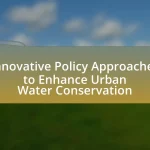The article focuses on the significance of stakeholder engagement in water conservation legislation, highlighting its role in creating effective and sustainable policies. It emphasizes that involving diverse stakeholders—such as local communities, businesses, and environmental organizations—leads to better resource management and higher compliance rates. The article discusses the challenges faced in engaging stakeholders, including conflicting interests and communication barriers, and outlines strategies to enhance participation, such as transparent communication and the use of technology. Additionally, it provides examples of successful stakeholder engagement in water legislation and underscores the importance of collaboration and data-driven decision-making for effective conservation outcomes.
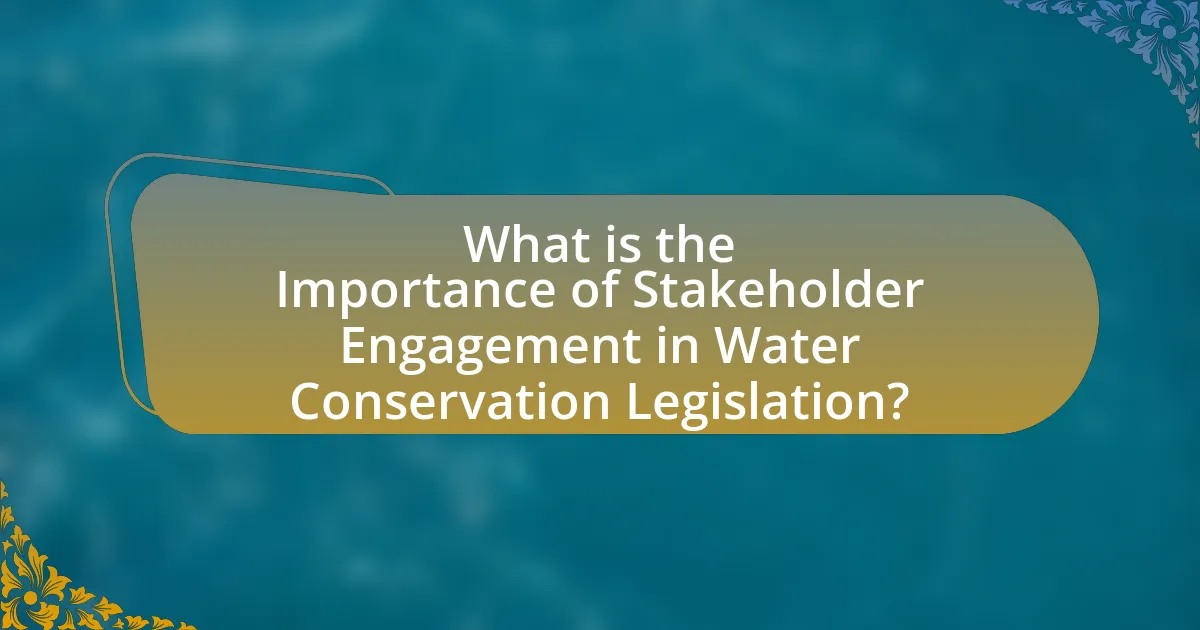
What is the Importance of Stakeholder Engagement in Water Conservation Legislation?
Stakeholder engagement is crucial in water conservation legislation because it ensures that diverse perspectives and interests are considered, leading to more effective and sustainable policies. Engaging stakeholders, including local communities, businesses, and environmental organizations, fosters collaboration and builds trust, which is essential for the successful implementation of water conservation measures. Research indicates that inclusive decision-making processes result in higher compliance rates and better resource management outcomes, as stakeholders are more likely to support initiatives they helped shape. For example, the U.S. Environmental Protection Agency emphasizes that stakeholder involvement enhances the legitimacy and effectiveness of water management strategies, ultimately contributing to the long-term sustainability of water resources.
Why is stakeholder engagement crucial for effective water conservation legislation?
Stakeholder engagement is crucial for effective water conservation legislation because it ensures that diverse perspectives and needs are considered in the decision-making process. Engaging stakeholders, such as local communities, businesses, and environmental organizations, fosters collaboration and builds trust, which is essential for the successful implementation of water policies. Research indicates that inclusive stakeholder participation leads to more sustainable and accepted outcomes, as evidenced by case studies where community involvement resulted in increased compliance and innovative solutions to water management challenges.
What roles do different stakeholders play in water conservation efforts?
Different stakeholders play crucial roles in water conservation efforts by influencing policies, implementing practices, and raising awareness. Government agencies establish regulations and provide funding for conservation projects, while non-governmental organizations advocate for sustainable practices and educate the public on water issues. Local communities engage in conservation activities, such as watershed management and water-saving initiatives, directly impacting their environment. Businesses adopt sustainable water use practices and invest in technologies that reduce water consumption. Research indicates that collaborative efforts among these stakeholders lead to more effective water management strategies, as seen in successful programs like the California State Water Resources Control Board’s initiatives, which involve diverse stakeholder participation to address water scarcity challenges.
How does stakeholder engagement influence policy outcomes?
Stakeholder engagement significantly influences policy outcomes by ensuring that diverse perspectives and interests are considered in the decision-making process. When stakeholders, such as community members, environmental groups, and industry representatives, actively participate, they provide valuable insights that can lead to more effective and sustainable policies. For instance, research conducted by the International Association for Public Participation highlights that inclusive stakeholder engagement can enhance the legitimacy and acceptance of policies, resulting in higher compliance rates and better implementation. This demonstrates that when stakeholders feel heard and valued, they are more likely to support and adhere to the resulting policies, ultimately improving the effectiveness of water conservation legislation.
What challenges exist in engaging stakeholders for water conservation?
Engaging stakeholders for water conservation faces several challenges, including diverse interests, lack of awareness, and communication barriers. Diverse interests among stakeholders, such as agricultural, industrial, and residential users, often lead to conflicting priorities, making consensus difficult. Additionally, many stakeholders may lack awareness of the importance of water conservation, resulting in low participation levels. Communication barriers, including technical jargon and insufficient outreach efforts, further hinder effective engagement. These challenges can impede the development and implementation of effective water conservation strategies, as evidenced by studies showing that stakeholder involvement is crucial for successful water management initiatives.
What barriers do stakeholders face in participating in water conservation legislation?
Stakeholders face several barriers in participating in water conservation legislation, including lack of awareness, limited resources, and conflicting interests. Lack of awareness about the legislation and its implications can prevent stakeholders from engaging effectively. Limited resources, such as financial constraints or insufficient manpower, hinder their ability to participate actively in the legislative process. Additionally, conflicting interests among various stakeholders, such as agricultural, industrial, and environmental groups, can create challenges in reaching a consensus on water conservation measures. These barriers collectively impede meaningful stakeholder engagement in the formulation and implementation of water conservation legislation.
How can these challenges be overcome to enhance engagement?
To overcome challenges in stakeholder engagement for water conservation legislation, implementing targeted communication strategies is essential. These strategies should include clear messaging that highlights the benefits of water conservation, tailored outreach efforts to different stakeholder groups, and the use of interactive platforms for feedback and discussion. Research indicates that effective communication can increase stakeholder participation by up to 40%, as demonstrated in case studies from successful water management programs. Additionally, fostering partnerships with local organizations can enhance trust and collaboration, further driving engagement.
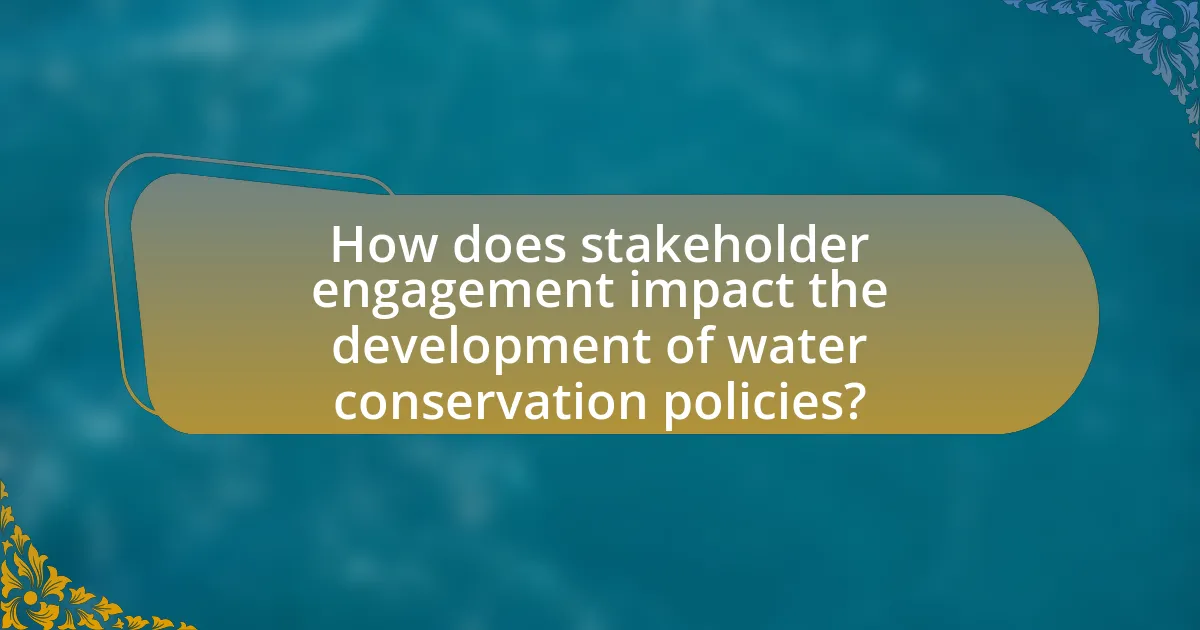
How does stakeholder engagement impact the development of water conservation policies?
Stakeholder engagement significantly enhances the development of water conservation policies by ensuring that diverse perspectives and expertise are incorporated into the decision-making process. Engaging stakeholders, such as local communities, environmental organizations, and industry representatives, fosters collaboration and builds trust, which is essential for effective policy implementation. Research indicates that policies developed with stakeholder input are more likely to address the specific needs and concerns of affected populations, leading to higher compliance rates and better environmental outcomes. For instance, a study by the United Nations Environment Programme found that inclusive stakeholder engagement in water management resulted in more sustainable practices and improved water quality in various regions.
What are the key benefits of involving stakeholders in policy formulation?
Involving stakeholders in policy formulation enhances the relevance and effectiveness of policies. Stakeholder engagement ensures that diverse perspectives are considered, leading to more comprehensive solutions that address the needs of various groups. For instance, research by the International Association for Public Participation indicates that inclusive processes can increase public trust and support for policies, as stakeholders feel their voices are heard and valued. Additionally, involving stakeholders can improve the implementation of policies, as those who contribute to the formulation are more likely to support and adhere to the outcomes.
How does stakeholder input improve the effectiveness of water conservation measures?
Stakeholder input enhances the effectiveness of water conservation measures by ensuring that diverse perspectives and local knowledge are integrated into decision-making processes. This inclusion leads to more tailored and practical solutions that address specific community needs and environmental conditions. For instance, studies have shown that when local farmers participate in water management discussions, they can provide insights on irrigation practices that significantly reduce water usage while maintaining crop yields. Additionally, stakeholder engagement fosters a sense of ownership and accountability among community members, which can lead to increased compliance with conservation initiatives. Research indicates that programs with active stakeholder involvement report higher success rates in achieving water conservation goals, as evidenced by the collaborative efforts in California’s Sustainable Groundwater Management Act, which resulted in improved groundwater management practices across various regions.
What examples illustrate successful stakeholder engagement in water legislation?
Successful stakeholder engagement in water legislation is exemplified by the collaborative efforts seen in the development of the Clean Water Act in the United States. This legislation involved extensive input from various stakeholders, including environmental groups, industry representatives, and local communities, which led to more comprehensive and effective regulations. Additionally, the European Water Framework Directive showcases successful engagement by requiring member states to involve stakeholders in the planning and implementation processes, resulting in improved water quality and management practices across Europe. These examples demonstrate that inclusive dialogue and collaboration among diverse stakeholders can lead to more effective water legislation and better environmental outcomes.
How can stakeholder engagement be effectively implemented in water conservation initiatives?
Stakeholder engagement can be effectively implemented in water conservation initiatives by establishing clear communication channels and involving diverse groups in decision-making processes. Engaging stakeholders such as local communities, government agencies, and environmental organizations ensures that multiple perspectives are considered, leading to more comprehensive and sustainable solutions. Research indicates that initiatives with active stakeholder participation, like the 2018 case study in California’s water management, resulted in improved water use efficiency and community support, demonstrating the effectiveness of collaborative approaches in achieving conservation goals.
What strategies can be employed to foster stakeholder collaboration?
To foster stakeholder collaboration, organizations can implement strategies such as establishing clear communication channels, creating inclusive decision-making processes, and building trust through transparency. Clear communication channels ensure that all stakeholders are informed and can share their perspectives, which is crucial in water conservation legislation where diverse interests exist. Inclusive decision-making processes allow stakeholders to participate actively, leading to more comprehensive solutions that consider various viewpoints. Building trust through transparency involves sharing information openly about goals, challenges, and progress, which has been shown to enhance cooperation among stakeholders, as evidenced by successful water management initiatives in various regions.
How can technology facilitate stakeholder engagement in water conservation?
Technology can facilitate stakeholder engagement in water conservation by providing platforms for communication, data sharing, and collaborative decision-making. Digital tools such as mobile applications and online forums enable stakeholders, including community members, government agencies, and NGOs, to share information and express concerns regarding water management practices. For instance, geographic information systems (GIS) allow stakeholders to visualize water resources and usage patterns, fostering informed discussions. Additionally, social media campaigns can raise awareness and mobilize community action, as evidenced by initiatives like the #SaveWater movement, which has successfully engaged millions in conservation efforts. These technological advancements enhance transparency and inclusivity, ultimately leading to more effective water conservation strategies.
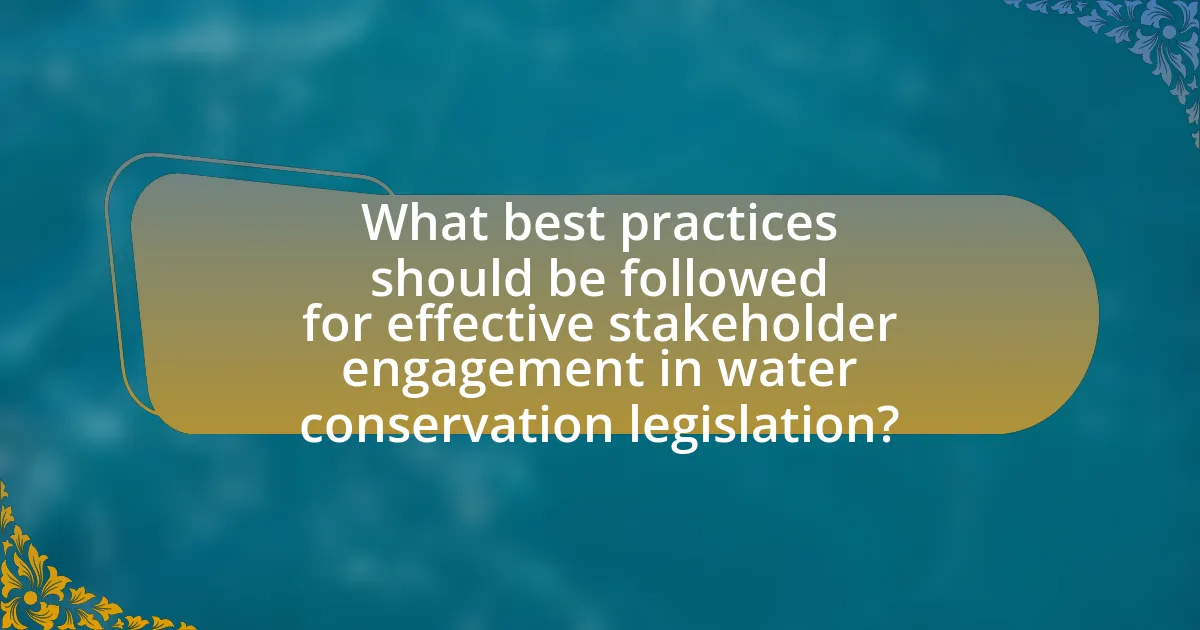
What best practices should be followed for effective stakeholder engagement in water conservation legislation?
Effective stakeholder engagement in water conservation legislation requires inclusive participation, transparent communication, and ongoing collaboration. Inclusive participation ensures that all relevant stakeholders, including local communities, government agencies, and environmental organizations, are involved in the decision-making process, which fosters a sense of ownership and accountability. Transparent communication involves sharing information about legislative processes, objectives, and outcomes, which builds trust and encourages stakeholder feedback. Ongoing collaboration, characterized by regular meetings and updates, allows stakeholders to remain engaged and informed, facilitating adaptive management of water resources. Research indicates that these practices lead to more effective and sustainable water conservation outcomes, as evidenced by case studies where stakeholder involvement resulted in improved policy implementation and community support.
What methods can be used to ensure inclusive stakeholder participation?
To ensure inclusive stakeholder participation, methods such as conducting stakeholder mapping, utilizing surveys and questionnaires, and organizing focus groups can be employed. Stakeholder mapping identifies all relevant parties, ensuring diverse perspectives are included in the decision-making process. Surveys and questionnaires gather quantitative and qualitative data from a broad audience, allowing for the collection of varied opinions and experiences. Focus groups facilitate in-depth discussions among selected stakeholders, promoting dialogue and understanding of different viewpoints. These methods have been shown to enhance engagement and lead to more comprehensive water conservation legislation by incorporating the insights and needs of all stakeholders involved.
How can feedback mechanisms enhance stakeholder involvement?
Feedback mechanisms enhance stakeholder involvement by facilitating two-way communication, allowing stakeholders to express their opinions and concerns while also receiving information about decisions and actions. This interactive process fosters trust and transparency, which are essential for effective engagement. Research indicates that when stakeholders feel heard and valued, their commitment to initiatives, such as water conservation legislation, increases significantly. For instance, a study by the International Association for Public Participation found that projects with robust feedback systems saw a 30% increase in stakeholder participation rates compared to those without such mechanisms. This evidence underscores the critical role of feedback in promoting active involvement and collaboration among stakeholders.
What role does transparency play in stakeholder engagement?
Transparency is crucial in stakeholder engagement as it fosters trust and encourages open communication among all parties involved. When stakeholders are provided with clear, accessible information regarding decisions, processes, and outcomes, they are more likely to feel valued and included in the decision-making process. Research indicates that organizations that prioritize transparency experience higher levels of stakeholder satisfaction and collaboration, which can lead to more effective water conservation initiatives. For instance, a study by the International Institute for Environment and Development found that transparent practices in environmental governance significantly enhance stakeholder participation and commitment to sustainable practices.
What are the key takeaways for stakeholders involved in water conservation legislation?
Key takeaways for stakeholders involved in water conservation legislation include the necessity of collaboration, the importance of data-driven decision-making, and the need for public awareness and education. Collaboration among stakeholders, such as government agencies, non-profits, and local communities, enhances the effectiveness of legislation by integrating diverse perspectives and resources. Data-driven decision-making is crucial, as it allows stakeholders to assess water usage patterns and identify areas for improvement, supported by studies indicating that informed policies lead to better conservation outcomes. Lastly, fostering public awareness and education ensures community support and participation, which is vital for the success of conservation initiatives, as evidenced by programs that have successfully engaged the public in sustainable practices.
How can stakeholders maximize their impact on water conservation policies?
Stakeholders can maximize their impact on water conservation policies by actively participating in the policy-making process, advocating for sustainable practices, and collaborating with governmental and non-governmental organizations. Engaging in public consultations allows stakeholders to voice their concerns and suggestions, which can lead to more effective and inclusive policies. For instance, studies show that regions with strong stakeholder involvement in water management, such as the European Union’s Water Framework Directive, have seen improved water quality and resource management outcomes. Additionally, stakeholders can leverage data and research to support their positions, ensuring that policies are based on scientific evidence and best practices.
What resources are available to support stakeholder engagement efforts?
Resources available to support stakeholder engagement efforts include community workshops, online platforms, and stakeholder mapping tools. Community workshops facilitate direct interaction and feedback from stakeholders, enhancing understanding and collaboration. Online platforms, such as social media and dedicated websites, provide accessible channels for information sharing and dialogue. Stakeholder mapping tools help identify and analyze the interests and influence of various stakeholders, ensuring targeted engagement strategies. These resources are essential for effective communication and collaboration in water conservation legislation, as evidenced by successful case studies where stakeholder involvement led to more comprehensive and accepted policies.
